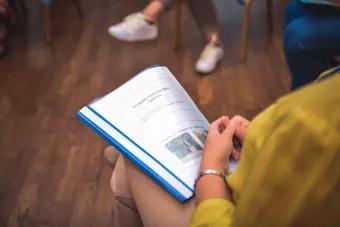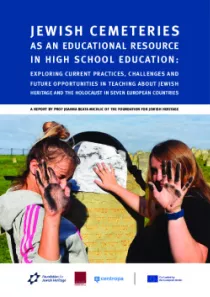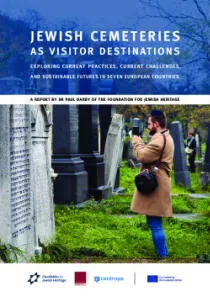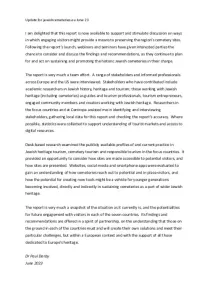
Curriculum Research
Dr Joanna Michlic was assigned to investigate the secondary school systems and authorities in each of the seven selected countries to understand the extent to which Jewish cemeteries and the Jewish experience is currently incorporated within school curriculums; where decision making lies and how to impact the systems, and the openness of teacher training institutes to address the topic.
This report confirms that in all seven pilot countries, an enthusiastic group of teachers and educators in formal and informal high school education agree that the space of Jewish cemeteries should be used in raising awareness, teaching and education about the rich pre-1939 Jewish social and cultural history and Jewish spiritual and material heritage. In most communities across the region, the Jewish cemeteries (and the restored or neglected synagogues) are the only remaining tangible physical proof that Jewish life and the Jews were an integral part of these places and the social, cultural, political and economic fabric of societies.
At present, teachers often lack specific pedagogical and methodological resources in their native/domestic languages to teach about the local Jewish past and to conduct research with students leading to specific outcomes. The incorporation of Jewish cemeteries into Local History needs regular educational exchanges in the form of regional and international seminars and workshops for teachers, and a provision for pedagogical and methodological resources across the region.
Both scholars and teachers recognize a great potential in incorporating Jewish cemeteries into teaching about the cutting-edge research in the social history of the Holocaust: topics such as rescue spaces, strategies of survival of individual Jews and Jewish families, and different forms of self-help among Jews. Some self-motivated, enthusiastic high school teachers in Poland, Slovakia and Ukraine have already taught about Jewish cemeteries as sites of perpetration and sites of rescue – hiding of Jewish fugitives.
However, overall teachers report a lack of sufficient pedagogical and methodological resources in native languages to teach about these subjects. In all seven countries, most individual high school teachers of History, Literature, Civic Studies/Ethics and Geography have enthusiastically endorsed the idea of Jewish cemetery as a rich educational resource. But they have stressed that they require in-service teachers’ training. Teachers recognize that the textbooks and pedagogical methods are bound together and define the outcome of learning.
The report concludes that international Jewish NGOs, such as Centropa and local NGOs are the only partners responsible for setting up the foundations for the implementation of teaching about Jewish heritage and the Holocaust in the framework of learning about democracy, opposing antisemitism, racism and xenophobia and strengthening civil society. Teachers have expressed a great need for participating in regular workshops and seminars run by international Jewish NGOs and local NGOs.
Tourism research
Dr Paul Darby was assigned to build on the initial results of the ESJF publication ‘Jewish Cemeteries and Sustainable Protection’ by conducting a feasibility study to explore the full potential of Jewish cemeteries as cultural tourist sites.
Researchers in the focus countries and at Centropa assisted in identifying and interviewing stakeholders as well as gathering local data for this report. A range of stakeholders and informed professionals across Europe and the US were interviewed. Stakeholders who have contributed include academic researchers in Jewish history, heritage and tourism; those working with Jewish heritage (including cemeteries) as guides and tourism professionals, tourism entrepreneurs, engaged community members and creators working with Jewish heritage. Where possible, statistics were collected to support understanding of tourist markets and access to digital resources.
Desk-based research examined the publicly available profiles of and current practice in Jewish heritage tourism, cemetery tourism and responsible tourism in the focus countries. Websites, social media and smartphone apps were evaluated to gain an understanding of how cemeteries reach out to potential and in place visitors, and how the potential for creating new tools might be a vehicle for younger generations becoming involved, directly and indirectly in sustaining cemeteries as a part of wider Jewish heritage.
Each country report is very much a ‘snap-shot’ of the situation as it currently is, and the potentialities for the future. It is not intended to be an in-depth study of each of the countries and is not exhaustive of the resources and initiatives which are taking place. Stakeholders in each country will of course want to take forward ideas which are contextualised for their circumstances.
This report aims to share current practice and act as a springboard for further work in the focus countries and is offered to provide possible solutions for those securing and promoting Jewish cemetery sites for future generations of visitors.
Legal research
Legal research will be conducted to map issues around the ownership and monument protection laws relevant for designing preservation projects for Jewish cemeteries in each country; research about the potential for Jewish cemeteries and other heritage assets for regional development will be conducted, focusing on the challenges faced by rural areas.
A task force of legal experts will identify contested areas in each project country, exploring ways to raise awareness and lobby for change. A web-based tool for legal challenges will aid stakeholders in learning about relevant law, regulations and potential challenges for preservation projects they are planning.



